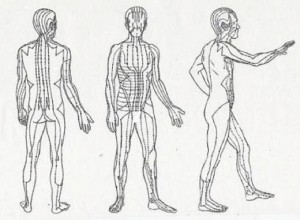In acupuncture, a meridian includes the system of channels and their collaterals which are thought to connect all body parts and most acupuncture points are located on them.
There are 12 bilaterally distributed meridians—lung meridian of the hand (Tai Yin), heart m. of the hand (Shao Yin), pericardium m. of the hand (Jue Yin), large intestine m. of the hand (Yang Ming), small intestine m. of the hand (Tai Yang), triple heater m. of the hand (Shao Yang), stomach m. of the foot (Yang Ming), urinary bladder m. of the foot (Tia Yang), gallbladder m. of the foot (Shao Yang), spleen m. of the foot (Tao Yin), kidney m. of the foot (Shao Yin), liver m. of the foot (Jue Yin).
Meridian points are acupuncture points located on one of the meridians.
Meridian theory
Traditional Chinese medicine is based on the theory that all body parts are connected by a network of main and collateral channels along which are situated the bulk of the acupuncture points. There are also some meridians, the dorsally located Governing Vessel and the ventrally located Conception Vessel, which are not connected to specific anatomical organs.

